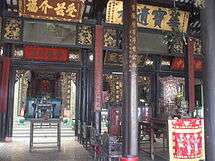Minh Hương
Minh Hương (Hán tự: 明鄉 or 明香) refers to descendants of Ming dynasty immigrants who settled in southern Vietnam during the 16th and 18th centuries. They were among the first wave of ethnic Chinese who came to southern Vietnam.
| Total population | |
|---|---|
| 約1000[1]:8 | |
| Regions with significant populations | |
| 約1000[1]:8 | |
| Languages | |
| Vietnamese, also used various Chinese Languages in the past | |
| Religion | |
| Predominantly Chinese and Vietnamese folk religion syncretized with Mahayana Buddhism. | |
| Related ethnic groups | |
| Kinh people, Hoa people, Khmer people and Ngái people | |

Han Chinese Ming dynasty refugees numbering 3,000 came to Vietnam at the end of the Ming dynasty. They opposed the Qing dynasty and were fiercely loyal to the Ming dynasty. Vietnamese women married these Han Chinese refugees since most of them were soldiers and single men. Their descendants became known as Minh Hương and they strongly identified as Chinese despite influence from Vietnamese mothers. They did not wear Manchu hairstyle unlike later Chinese migrants to Vietnam during the Qing dynasty.[2]
After Manchu conquest of China, many Han Chinese people who refused to submit themselves to Manchu people fled abroad. Ethnic Chinese leaders such as Mạc Cửu, Trần Thượng Xuyên and Dương Ngạn Địch, arrived in Mekong Delta where they established their own polities in Ha Tien, Bien Hoa and My Tho. They later submitted to the Nguyễn lords, who provided them with noble titles and offer protection against Khmer and Siam threats. Many Minh Hương such as Trịnh Hoài Đức and Ngô Nhân Tịnh became Nguyen ministers and played important roles in the Vietnamese exploration and settlement of Mekong Delta.
At first the Hán tự was 明香 ("those who worship Ming dynasty ancestrals"). It was changed to 明鄉 ("of Ming dynasty origins") in 1827 as ordered by emperor Minh Mạng of Nguyễn dynasty.[3] In official records of Nguyễn dynasty, they were called Minh nhân (明人) or Minh Hương to distinguish with those ethnic Chinese (Thanh nhân 清人) from Qing China.
Minh Hương often married with local Viet (Kinh) people. Since 1829, Minh Hương were treated as Vietnamese instead of Chinese.[1][4]:272 They were not allowed to go to China, and also not allowed to wear the Manchu queue.[5]
In the present day, most of Minh Hương adopt Vietnamese culture. They are regarded as Kinh people instead of Hoa people by the Vietnamese government.[1]:3 They also recognize themselves as Kinh people.[1]:6
Famous Minh Hương
- Dương Ngạn Địch (楊彥迪): general of Nguyễn lord, ruler of Biên Hòa.
- Trần Thượng Xuyên (陳上川): general of Nguyễn lord, ruler of Mỹ Tho.
- Trần Đại Định (陳大定): general of Nguyễn lord
- Trần Đại Lực (陳大力): general of Nguyễn lord
- Mạc Cửu (鄚玖): ruler of Hà Tiên
- Mạc Thiên Tứ (鄚天賜): ruler of Hà Tiên
- Mạc Tử Sanh (鄚子泩): general of Nguyễn lord
- Võ Trường Toản (武長纘): scholar in 18th century
- Trịnh Hoài Đức (鄭懷德): mandarin and scholar during Gia Long's reign
- Ngô Nhân Tịnh (吳仁靜): mandarin and scholar during Gia Long's reign
- Phan Thanh Giản (潘清簡): mandarin during Tự Đức's reign
- Trần Tiễn Thành (陳踐誠): mandarin during Tự Đức's reign
References
- 蔣為文 (2013). "越南的明鄉人與華人移民的族群認同與本土化差異" (PDF). 台灣國際研究季刊 (in Chinese). 國立成功大學越南研究中心. 9 (4): 8. Retrieved 2014-06-23.
- Choi, Byung Wook (2018). Southern Vietnam under the Reign of Minh Mang (1820–1841): Central Policies and Local Response. Book collections on Project MUSE (illustrated ed.). Cornell University Press. p. 39. ISBN 1501719521.
- Nguyễn Đức Hiệp. Về lịch sử người Minh Hương và người Hoa ở Nam bộ.
- Leo Suryadinata (1997). Ethnic Chinese as Southeast Asians. Institute of Southeast Asian Studies. ISBN 9813055502. Retrieved 2014-07-07.
- "明鄉人". Chinese Encyclopedia (in Chinese). Chinese Culture University. 1983. Retrieved 2014-06-24.